Xuehan Xiong
Carnegie Mellon University
Seed1.5-VL Technical Report
May 11, 2025Abstract:We present Seed1.5-VL, a vision-language foundation model designed to advance general-purpose multimodal understanding and reasoning. Seed1.5-VL is composed with a 532M-parameter vision encoder and a Mixture-of-Experts (MoE) LLM of 20B active parameters. Despite its relatively compact architecture, it delivers strong performance across a wide spectrum of public VLM benchmarks and internal evaluation suites, achieving the state-of-the-art performance on 38 out of 60 public benchmarks. Moreover, in agent-centric tasks such as GUI control and gameplay, Seed1.5-VL outperforms leading multimodal systems, including OpenAI CUA and Claude 3.7. Beyond visual and video understanding, it also demonstrates strong reasoning abilities, making it particularly effective for multimodal reasoning challenges such as visual puzzles. We believe these capabilities will empower broader applications across diverse tasks. In this report, we mainly provide a comprehensive review of our experiences in building Seed1.5-VL across model design, data construction, and training at various stages, hoping that this report can inspire further research. Seed1.5-VL is now accessible at https://www.volcengine.com/ (Volcano Engine Model ID: doubao-1-5-thinking-vision-pro-250428)
Streaming Dense Video Captioning
Apr 01, 2024Abstract:An ideal model for dense video captioning -- predicting captions localized temporally in a video -- should be able to handle long input videos, predict rich, detailed textual descriptions, and be able to produce outputs before processing the entire video. Current state-of-the-art models, however, process a fixed number of downsampled frames, and make a single full prediction after seeing the whole video. We propose a streaming dense video captioning model that consists of two novel components: First, we propose a new memory module, based on clustering incoming tokens, which can handle arbitrarily long videos as the memory is of a fixed size. Second, we develop a streaming decoding algorithm that enables our model to make predictions before the entire video has been processed. Our model achieves this streaming ability, and significantly improves the state-of-the-art on three dense video captioning benchmarks: ActivityNet, YouCook2 and ViTT. Our code is released at https://github.com/google-research/scenic.
Gemini 1.5: Unlocking multimodal understanding across millions of tokens of context
Mar 08, 2024Abstract:In this report, we present the latest model of the Gemini family, Gemini 1.5 Pro, a highly compute-efficient multimodal mixture-of-experts model capable of recalling and reasoning over fine-grained information from millions of tokens of context, including multiple long documents and hours of video and audio. Gemini 1.5 Pro achieves near-perfect recall on long-context retrieval tasks across modalities, improves the state-of-the-art in long-document QA, long-video QA and long-context ASR, and matches or surpasses Gemini 1.0 Ultra's state-of-the-art performance across a broad set of benchmarks. Studying the limits of Gemini 1.5 Pro's long-context ability, we find continued improvement in next-token prediction and near-perfect retrieval (>99%) up to at least 10M tokens, a generational leap over existing models such as Claude 2.1 (200k) and GPT-4 Turbo (128k). Finally, we highlight surprising new capabilities of large language models at the frontier; when given a grammar manual for Kalamang, a language with fewer than 200 speakers worldwide, the model learns to translate English to Kalamang at a similar level to a person who learned from the same content.
Gemini: A Family of Highly Capable Multimodal Models
Dec 19, 2023Abstract:This report introduces a new family of multimodal models, Gemini, that exhibit remarkable capabilities across image, audio, video, and text understanding. The Gemini family consists of Ultra, Pro, and Nano sizes, suitable for applications ranging from complex reasoning tasks to on-device memory-constrained use-cases. Evaluation on a broad range of benchmarks shows that our most-capable Gemini Ultra model advances the state of the art in 30 of 32 of these benchmarks - notably being the first model to achieve human-expert performance on the well-studied exam benchmark MMLU, and improving the state of the art in every one of the 20 multimodal benchmarks we examined. We believe that the new capabilities of Gemini models in cross-modal reasoning and language understanding will enable a wide variety of use cases and we discuss our approach toward deploying them responsibly to users.
UnLoc: A Unified Framework for Video Localization Tasks
Aug 21, 2023



Abstract:While large-scale image-text pretrained models such as CLIP have been used for multiple video-level tasks on trimmed videos, their use for temporal localization in untrimmed videos is still a relatively unexplored task. We design a new approach for this called UnLoc, which uses pretrained image and text towers, and feeds tokens to a video-text fusion model. The output of the fusion module are then used to construct a feature pyramid in which each level connects to a head to predict a per-frame relevancy score and start/end time displacements. Unlike previous works, our architecture enables Moment Retrieval, Temporal Localization, and Action Segmentation with a single stage model, without the need for action proposals, motion based pretrained features or representation masking. Unlike specialized models, we achieve state of the art results on all three different localization tasks with a unified approach. Code will be available at: \url{https://github.com/google-research/scenic}.
End-to-End Spatio-Temporal Action Localisation with Video Transformers
Apr 24, 2023



Abstract:The most performant spatio-temporal action localisation models use external person proposals and complex external memory banks. We propose a fully end-to-end, purely-transformer based model that directly ingests an input video, and outputs tubelets -- a sequence of bounding boxes and the action classes at each frame. Our flexible model can be trained with either sparse bounding-box supervision on individual frames, or full tubelet annotations. And in both cases, it predicts coherent tubelets as the output. Moreover, our end-to-end model requires no additional pre-processing in the form of proposals, or post-processing in terms of non-maximal suppression. We perform extensive ablation experiments, and significantly advance the state-of-the-art results on four different spatio-temporal action localisation benchmarks with both sparse keyframes and full tubelet annotations.
Beyond Transfer Learning: Co-finetuning for Action Localisation
Jul 08, 2022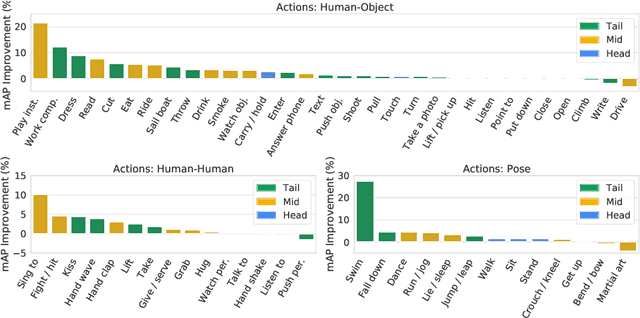

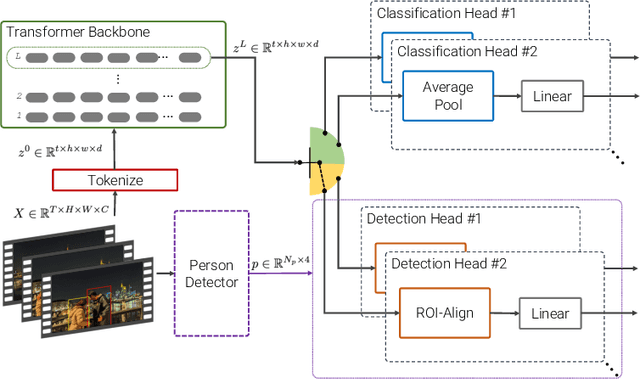
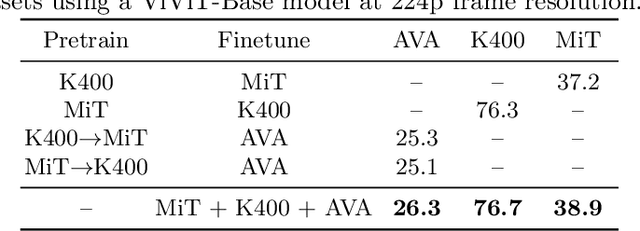
Abstract:Transfer learning is the predominant paradigm for training deep networks on small target datasets. Models are typically pretrained on large ``upstream'' datasets for classification, as such labels are easy to collect, and then finetuned on ``downstream'' tasks such as action localisation, which are smaller due to their finer-grained annotations. In this paper, we question this approach, and propose co-finetuning -- simultaneously training a single model on multiple ``upstream'' and ``downstream'' tasks. We demonstrate that co-finetuning outperforms traditional transfer learning when using the same total amount of data, and also show how we can easily extend our approach to multiple ``upstream'' datasets to further improve performance. In particular, co-finetuning significantly improves the performance on rare classes in our downstream task, as it has a regularising effect, and enables the network to learn feature representations that transfer between different datasets. Finally, we observe how co-finetuning with public, video classification datasets, we are able to achieve state-of-the-art results for spatio-temporal action localisation on the challenging AVA and AVA-Kinetics datasets, outperforming recent works which develop intricate models.
M&M Mix: A Multimodal Multiview Transformer Ensemble
Jun 20, 2022



Abstract:This report describes the approach behind our winning solution to the 2022 Epic-Kitchens Action Recognition Challenge. Our approach builds upon our recent work, Multiview Transformer for Video Recognition (MTV), and adapts it to multimodal inputs. Our final submission consists of an ensemble of Multimodal MTV (M&M) models varying backbone sizes and input modalities. Our approach achieved 52.8% Top-1 accuracy on the test set in action classes, which is 4.1% higher than last year's winning entry.
Multiview Transformers for Video Recognition
Jan 20, 2022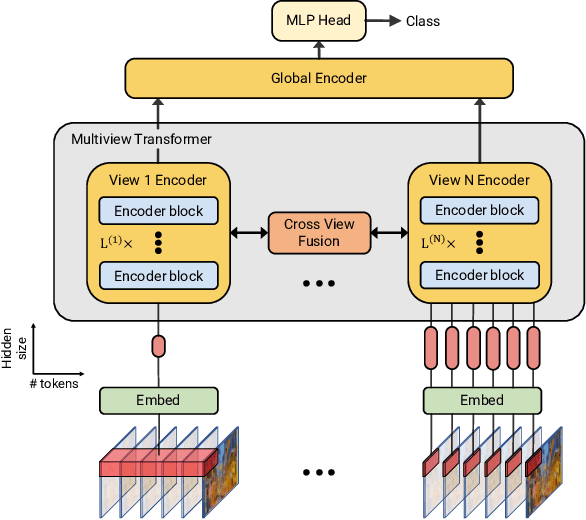
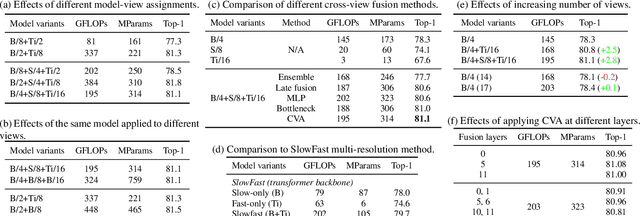

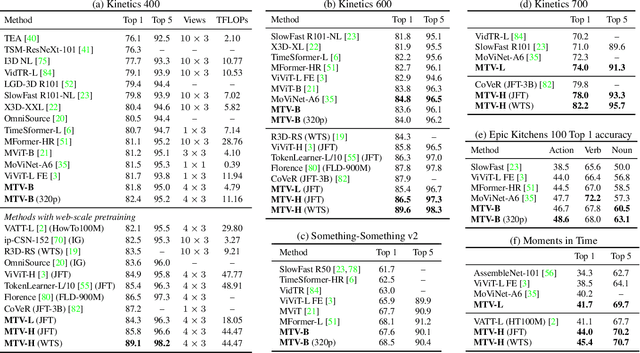
Abstract:Video understanding requires reasoning at multiple spatiotemporal resolutions -- from short fine-grained motions to events taking place over longer durations. Although transformer architectures have recently advanced the state-of-the-art, they have not explicitly modelled different spatiotemporal resolutions. To this end, we present Multiview Transformers for Video Recognition (MTV). Our model consists of separate encoders to represent different views of the input video with lateral connections to fuse information across views. We present thorough ablation studies of our model and show that MTV consistently performs better than single-view counterparts in terms of accuracy and computational cost across a range of model sizes. Furthermore, we achieve state-of-the-art results on five standard datasets, and improve even further with large-scale pretraining. We will release code and pretrained checkpoints.
Learning from Weakly-labeled Web Videos via Exploring Sub-Concepts
Jan 11, 2021



Abstract:Learning visual knowledge from massive weakly-labeled web videos has attracted growing research interests thanks to the large corpus of easily accessible video data on the Internet. However, for video action recognition, the action of interest might only exist in arbitrary clips of untrimmed web videos, resulting in high label noises in the temporal space. To address this issue, we introduce a new method for pre-training video action recognition models using queried web videos. Instead of trying to filter out, we propose to convert the potential noises in these queried videos to useful supervision signals by defining the concept of Sub-Pseudo Label (SPL). Specifically, SPL spans out a new set of meaningful "middle ground" label space constructed by extrapolating the original weak labels during video querying and the prior knowledge distilled from a teacher model. Consequently, SPL provides enriched supervision for video models to learn better representations. SPL is fairly simple and orthogonal to popular teacher-student self-training frameworks without extra training cost. We validate the effectiveness of our method on four video action recognition datasets and a weakly-labeled image dataset to study the generalization ability. Experiments show that SPL outperforms several existing pre-training strategies using pseudo-labels and the learned representations lead to competitive results when fine-tuning on HMDB-51 and UCF-101 compared with recent pre-training methods.
 Add to Chrome
Add to Chrome Add to Firefox
Add to Firefox Add to Edge
Add to Edge